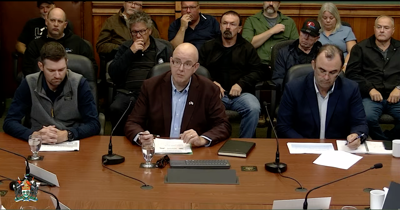Processors nervous for the future of the Island’s oyster industry

This article was written by Melissa Heald and originally published by West Prince Graphic on October 1, 2025. We are sharing the full text here for reference. All rights remain with the original publisher.

PEI Oyster Processors Association President Martin O’Brien, PEI Aquaculture Alliance Executive Director Peter Warris and PEI Seafood Processors Association Executive Director Bob Creed spoke with the Standing Committee on Natural Resources and Environmental Sustainability on the impacts MSX and Dermo have had on the oyster industry following the spring season on Sept 25. Youtube screenshot
Oyster industry representatives were ringing the alarm bells when presenting to the Standing Committee on Natural Resources and Environmental Sustainability on Sept 25.
With 14.6 million pound of oysters landed on PEI in 2024, worth a value of $27 million, which combines both cultured and the public fisheries, PEI Aquaculture Alliance Executive Director Peter Warris called the Island’s oyster industry an economic generator.
“The PEI oyster industry is a true Island success story, and unless individuals and businesses are supported over the next five years, we will see the death of the industry as we know it today,” he said.
Joining Warris was PEI Seafood Processors Association Executive Director Bob Creed and PEI Oyster Processors Association President Martin O’Brien. They were there to discuss the impacts two parasitic diseases, MSX and Dermo, are having on the oyster industry following the spring season.
MSX was first detected in PEI waters in 2024 and Dermo in 2025. Both parasites have no impact on humans, but can cause significant mortalities in oysters.
Warris said growers are starting to see ongoing significant mortalities because of the parasites – around 80 per cent in most cases, up to 90 per cent in some others.
“Some were found over the winter and into the spring as cages were raised,” he said, adding even more were found later in the summer and into the fall.
“Many of these are in the Ellerslie and Bideford area and also in Enmore and Percival areas,” said Warris. “These areas have significantly been impacted.”
Warris said these areas represent roughly 14 per cent of the active growing areas on PEI.
“This has the potential to get much more worse and impact a lot more people,” he said. “In time it’s likely all oyster producing areas will see a similar devastating impact.”
Loss of sales has become another problem.
“Seed sales in Bideford, traditionally a major seed collection area and distribution area to other parts of the Island, have been devastated,” said Warris. “People don’t want to take seed from the area in case it transfers disease.”
Once Dermo was confirmed in the Enmore and Percival area, sales of market product from that area ‘basically stopped’, said Warris. “Those sales have fallen off 100 per cent.”
He added there have also been quality issues, including stunted growth and poor meat yields.
O’Brien, owner of the Cascumpec Bay Oyster Company, spoke about the impact these diseases are having on the processors.
He said processors are also growers and are facing challenges on both the farming and processing side.
O’Brien explained many processors supplement their supply by buying from other growers or from the public fishery.
“Historically, the method in which oysters are procured has placed significant risk on the oyster buyer and processor,” he said.
Due to regulations, O’Brien said processors are required to hold oysters for 21 days before taking them to market, and, in some cases, this can increase up to 4-6 months in the late fall or winter.
“MSX and Dermo increase the risk of mortalities while holding,” said O’Brien. “There are reports that some processors have had higher mortalities than would normally have been expected.”
He said processors are very nervous about building significant inventory for this upcoming winter season.
“We are hearing that financial institutions are starting to tighten credit availability as MSX and Dermo are better understood and impacts are realized,” said O’Brien.
However, despite the impact, O’Brien said markets remain good for the most part.
One area oyster growers and processors would like to see in way of assistance is a procurement support program.
“To help processors de-risk a little bit the buying and holding activity that they do,” said Creed.
Another support they would like for oyster growers is immediate financial relief for those affected by the mortalities and lack of sales.
“Otherwise we are going to lose them,” said Warris. “Families can’t live on nothing for an entire season.”
He added whatever supports are put into place, they need to be long-term.
Other areas of support include wage subsidies, review and discussion on the need for new marketing initiatives, employee work sharing and training supports.
In the long-term, broodstock programs for developing tolerant seed need to happen as well as cost-sharing programs for nursery equipment, investment in new hatchery operations, establishment of shellfish research centre at UPEI, new investments by DFO to increase in-house scientific research capability and a hatchery seed adoption program.
With approximately 250 active oyster lease holders in PEI, with 160 of them active in the public spring and fall fisheries and 20 licensed processors, the full public gallery of those attending the standing committee meeting was pointed out.
“There’s a good representation of fishers, growers and processors in the room today,” said Creed.
He added emotions are running high, with many nervous about the future of their industry.
“The importance and the serious of this issue facing the oyster industry can’t be overstated,” said Creed. “There’s a lot of uncertainty and this is a very difficult time for the oyster industry.”
Source: West Prince Graphic. Original article available here.
Recent News
This article was written by Elizabeth McMillan and originally published by CBC News on October 19, 2025. We are sharing…
This article was written by Jenna Banfield and originally published by CBC News on October 7, 2025 at 6:00AM ADT.…
This article was written by Melissa Heald and originally published by West Prince Graphic on October 1, 2025. We are…
This article was written by Stu Neatby and originally published by The Guardian on September 29, 2025. We are sharing…
This article was written by Marilee Devries and originally published by CBC News on September 25, 2025 at 9:27PM ADT.…
This document was originally circulated by the CFIA on August 28th, 2025. We are sharing the full text here for…
This article was written by Marilee Devries and originally published by CBC News on September 2, 2025 at 2:56PM ADT.…
This article was written by Maria Sarrouh and originally published by CTV News on August 16, 2025 at 5:00AM EDT. We…
This article was originally published by GenomeAtlantic in July, 2025. We are sharing the full text here for reference. All…
This article was written by Carolyn Ryan and originally published by CBC News on July 04, 2025 at 8:10PM ADT.…
